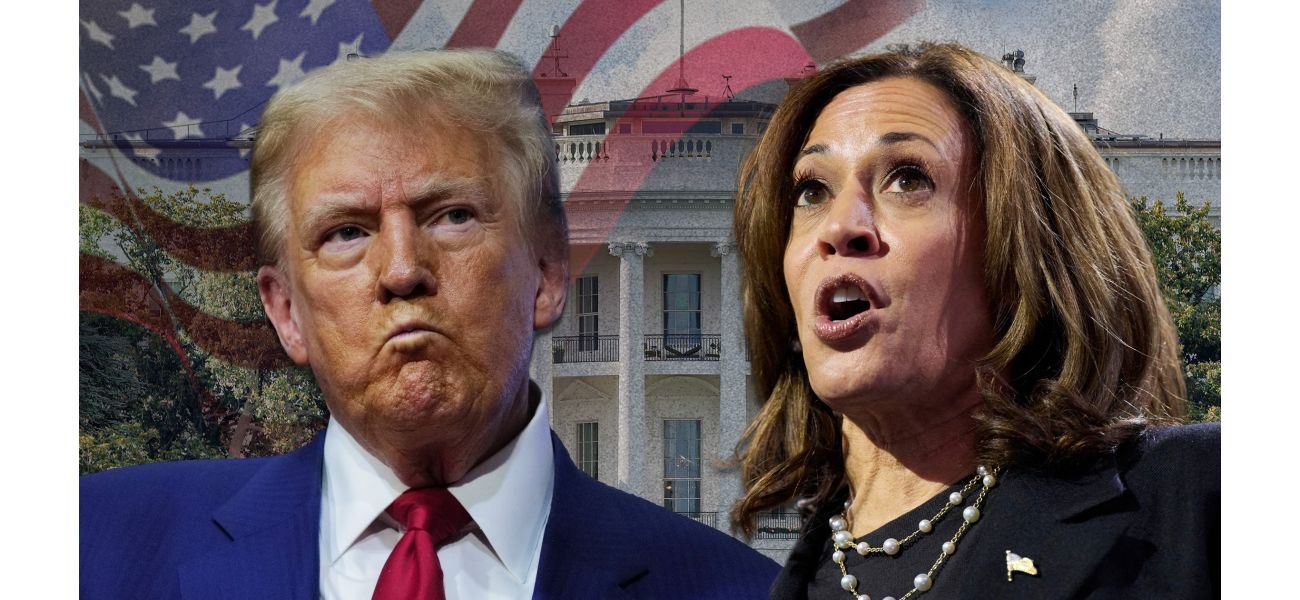When is Trump becoming president? Metro has answers about the US election.
Trump has emerged victorious in the US election- here's all the important information.
November 6th 2024.

Today, the much-awaited Election Day has finally arrived. After months of intense campaigning, the American people have spoken and declared Donald Trump as the winner of the 2024 US Presidential Election. However, before he can officially settle into the White House, there are still a few more steps that need to be taken.
Both Vice President Kamala Harris and former President Donald Trump put in a lot of effort to convince the voters that they were the best choice to lead the nation. And now, we have the answer as to who the American people have chosen as their next leader. But, for those unfamiliar with the American electoral process, it may come as a surprise that Election Day is actually just the first part of a two-part election.
The first part, known as the presidential general election, is where regular citizens cast their vote for their preferred presidential and vice-presidential candidates. However, the final decision is not in their hands. The second part of the election involves the Electoral College, a group of appointed individuals who cast their official vote for the candidates who won in their respective states. Only after this process is complete can the winning candidate officially become the President of the United States.
So, when will Donald Trump actually become the president? Well, despite winning the necessary 270 electoral votes, there are still some remaining stages of the election. The official tally from each state needs to be confirmed by election officials, which can take several weeks. The latest deadline for this is December 11 in Oregon. Then, on December 17, the appointed presidential electors from each state will officially cast their vote for the winning candidate. These votes will then be counted in Congress on January 6. And finally, on January 20, 2025, the inauguration ceremony will take place on the steps of the Capitol building in Washington DC, officially marking the beginning of Donald Trump's term as president.
Now, let's talk about the Electoral College. No, it's not an actual college that you can attend. It is a group of individuals who are responsible for electing the president and vice president. This process is not a popular vote, which means that the candidate who wins the popular vote may not necessarily win the election. This has happened in the past, with Hillary Clinton winning the popular vote in 2016, but ultimately losing the election due to the Electoral College system.
The Electoral College is made up of 538 electors, with each state being allocated a certain number of electors based on their number of senators and representatives in Congress. For example, Rhode Island has two senators and two representatives, giving them four electoral votes. The candidate who reaches 270 electoral votes first wins the election. However, many Americans believe that the Electoral College should be abolished, as it is seen as an archaic and convoluted system that may not accurately represent the will of the people.
So, who are these electors? They are individuals who are appointed by the political parties in each state and are pledged to vote for their party's candidate. They are often chosen from elected state officials, state party leaders, or locals with ties to the candidate.
Now, you may be wondering, do all of a state's Electoral College votes go to one candidate? The answer is yes, for most states. Other than Maine and Nebraska, states award all their electoral votes to the candidate who won the popular vote in that state. So, even if a candidate wins by a small margin, they will receive all of that state's electoral votes. This can lead to a discrepancy between the popular vote and the Electoral College vote, as we saw in the 2016 election.
Swing states, also known as battleground states, play a crucial role in deciding the outcome of the election. These states do not consistently vote for one party, making them unpredictable and highly sought after by both candidates. In the 2024 election, the seven swing states were Arizona, Georgia, Michigan, Nevada, North Carolina, Wisconsin, and Pennsylvania. These states received a lot of attention from both campaigns, as winning them can significantly impact the outcome of the election.
As for the question of whether a candidate has ever lost the popular vote but still become president, the answer is yes. This has happened in the past, with Donald Trump winning the 2016 election by a landslide in the Electoral College, despite losing the popular vote to Hillary Clinton.
As for when we will know the full results of the US Election, it's hard to say. While Trump has already won the necessary 270 electoral votes, there are still some states that have not finished counting all the votes. It can take days or even weeks for the final results to be announced. And even then, the results are not officially finalized until December 17, when the Electoral College members convene in each state to certify the results. The final declaration of the result in Congress will take place on January 6, and the inauguration ceremony will be held on January 20.
In the period between the election and the inauguration, known as the transition, the new administration will have time to appoint cabinet members and make plans for their term. This is an important time for the incoming president to prepare for their new role and start implementing their policies.
In conclusion, while Donald Trump has been declared the winner of the 2024 US Presidential Election, there are still several steps that need to be taken before he can officially become the 47th President of the United States. The American electoral process may seem complicated, but it is an essential part of their democratic system. And only time will tell what the future holds for the nation under the leadership of their newly elected president.
Both Vice President Kamala Harris and former President Donald Trump put in a lot of effort to convince the voters that they were the best choice to lead the nation. And now, we have the answer as to who the American people have chosen as their next leader. But, for those unfamiliar with the American electoral process, it may come as a surprise that Election Day is actually just the first part of a two-part election.
The first part, known as the presidential general election, is where regular citizens cast their vote for their preferred presidential and vice-presidential candidates. However, the final decision is not in their hands. The second part of the election involves the Electoral College, a group of appointed individuals who cast their official vote for the candidates who won in their respective states. Only after this process is complete can the winning candidate officially become the President of the United States.
So, when will Donald Trump actually become the president? Well, despite winning the necessary 270 electoral votes, there are still some remaining stages of the election. The official tally from each state needs to be confirmed by election officials, which can take several weeks. The latest deadline for this is December 11 in Oregon. Then, on December 17, the appointed presidential electors from each state will officially cast their vote for the winning candidate. These votes will then be counted in Congress on January 6. And finally, on January 20, 2025, the inauguration ceremony will take place on the steps of the Capitol building in Washington DC, officially marking the beginning of Donald Trump's term as president.
Now, let's talk about the Electoral College. No, it's not an actual college that you can attend. It is a group of individuals who are responsible for electing the president and vice president. This process is not a popular vote, which means that the candidate who wins the popular vote may not necessarily win the election. This has happened in the past, with Hillary Clinton winning the popular vote in 2016, but ultimately losing the election due to the Electoral College system.
The Electoral College is made up of 538 electors, with each state being allocated a certain number of electors based on their number of senators and representatives in Congress. For example, Rhode Island has two senators and two representatives, giving them four electoral votes. The candidate who reaches 270 electoral votes first wins the election. However, many Americans believe that the Electoral College should be abolished, as it is seen as an archaic and convoluted system that may not accurately represent the will of the people.
So, who are these electors? They are individuals who are appointed by the political parties in each state and are pledged to vote for their party's candidate. They are often chosen from elected state officials, state party leaders, or locals with ties to the candidate.
Now, you may be wondering, do all of a state's Electoral College votes go to one candidate? The answer is yes, for most states. Other than Maine and Nebraska, states award all their electoral votes to the candidate who won the popular vote in that state. So, even if a candidate wins by a small margin, they will receive all of that state's electoral votes. This can lead to a discrepancy between the popular vote and the Electoral College vote, as we saw in the 2016 election.
Swing states, also known as battleground states, play a crucial role in deciding the outcome of the election. These states do not consistently vote for one party, making them unpredictable and highly sought after by both candidates. In the 2024 election, the seven swing states were Arizona, Georgia, Michigan, Nevada, North Carolina, Wisconsin, and Pennsylvania. These states received a lot of attention from both campaigns, as winning them can significantly impact the outcome of the election.
As for the question of whether a candidate has ever lost the popular vote but still become president, the answer is yes. This has happened in the past, with Donald Trump winning the 2016 election by a landslide in the Electoral College, despite losing the popular vote to Hillary Clinton.
As for when we will know the full results of the US Election, it's hard to say. While Trump has already won the necessary 270 electoral votes, there are still some states that have not finished counting all the votes. It can take days or even weeks for the final results to be announced. And even then, the results are not officially finalized until December 17, when the Electoral College members convene in each state to certify the results. The final declaration of the result in Congress will take place on January 6, and the inauguration ceremony will be held on January 20.
In the period between the election and the inauguration, known as the transition, the new administration will have time to appoint cabinet members and make plans for their term. This is an important time for the incoming president to prepare for their new role and start implementing their policies.
In conclusion, while Donald Trump has been declared the winner of the 2024 US Presidential Election, there are still several steps that need to be taken before he can officially become the 47th President of the United States. The American electoral process may seem complicated, but it is an essential part of their democratic system. And only time will tell what the future holds for the nation under the leadership of their newly elected president.
[This article has been trending online recently and has been generated with AI. Your feed is customized.]
[Generative AI is experimental.]
0
0
Submit Comment





